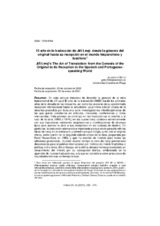El arte de la traducción de Jiří Levý: desde la génesis del original hasta su recepción en el mundo hispanófono y lusófono
Jiří Levý's The Art of Translation: from the Genesis of the Original to its Reception in the Spanish and Portuguese-speaking World
Autor
Getta, Elizaveta
Editor
UCOPressFecha
2021Materia
Jiři LevýEl arte de la traducción
Estructuralismo checo
Traductología
Historia de la traducción
The Art of Translation
Czech Structuralism
Translation Studies
History of Translation
METS:
Mostrar el registro METSPREMIS:
Mostrar el registro PREMISMetadatos
Mostrar el registro completo del ítemResumen
En este artículo tratamos de describir la génesis de la obra fundamental de Jiři Levý El arte de la traducción (1963) desde los primeros años de la década de los cincuenta, así como los avatares de su accidentada recepción internacional hasta la actualidad. La primera edición checa de la obra fue precedida por toda una serie investigaciones interdisciplinarias de las que queda constancia en artículos, manuales, conferencias y notas manuscritas. Este proceso se prolongó en las traducciones al alemán y al ruso de la obra (1969 y 1974), en las cuales Levý colaboró estrechamente con sus traductores realizando adaptaciones y modificaciones de diversos tipos para acercar la obra a sus receptores en las culturas de destino. En particular, la traducción alemana fue importante porque sirvió para difundir las ideas de Levý en el extranjero y también porque fungió, junto con el original checo, como patrón en la segunda edición checa de la obra, preparada por Karel Hausenblas en 1983, y que ha servido de modelo para todas las ediciones posteriores. Durante mucho tiempo la obra de Levý permaneció desconocida para el público internacional por motivos de índole lingüística y política, entre otros. Sin embargo, en la última década hemos presenciado un renacimiento del interés por su concepción teórica, evidenciado en la aparición de nuevas traducciones, a la que se considera como precursora de inquietudes teóricas contemporáneas. In this paper, we try to describe the genesis of Jiři Levý's groundbreaking work The Art of Translation (1963) from the early 1950s, as well as the vicissitudes of its international reception until the present day. The first Czech edition of the work was preceded by a whole series of interdisciplinary investigations recorded in articles, manuals, lectures and handwritten notes. This process was prolonged in the German and Russian translations of the work (1969 and 1974), in which Levý collaborated closely with his translators making adaptations and modifications of various kinds to bring the work closer to its recipients in the target cultures. In particular, the German translation was important because it served to spread Levý's ideas abroad and also because it acted, together with the Czech original, as a pattern in the second Czech edition of the work, prepared by Karel Hausenblas in 1983, which all subsequent editions have taken as model. For a long time, Levý's work remained unknown to international audiences for linguistic and political reasons, among others. However, in the last decade we have witnessed a revival of interest in his theoretical conception —evidenced in the appearance of new translations—which is considered now as a precursor of contemporary theoretical vistas.

